#that makes it harder to diversify as well
Text
What with the D&D/WotC OGL fiasco going on right now (google it, I don’t have the inclination to look up a link to something explicable at the moment), I’ve been thinking a lot about the pros and cons of other TTRPG systems, and what might appeal to gamers with different priorities. It’s a hard topic, because there are several reasons why D&D has been the cultural juggernaut it is. Longevity and advertising go a long way, yes, but in the 5E era, one of the things that has influenced a lot of people in my circles to try it is the particular combination of solid direction/format and freedom of imagination.
It feels a bit like fanfic - it gives us a “canon” to start with, where “canon” is a system of rules, parameters for characters, even stories, if you go with pre-written adventures. You just have to plug your own ideas into it and go from there. D&D makes it easy to start and continue the game, as long as you’re willing to put in the time to understand the rules. And the proliferation of Actual Plays (and other cultural touchstones) has made it that much easier to learn the rules in advance.
The issue, I think, is finding another system that will give players approximately the same combination of freedom and structure, and can be demonstrated to be flexible enough to tell a wide variety of stories.
I am a super fan of Powered By the Apocalypse systems, but one of the problems I have with running them is that there aren’t a whole lot of pre-written adventure paths. This makes them somewhat unwelcoming to people who are not used to making up their own stories - there’s some direction in the source books, yes, but they don’t have the same resources as D&D for inspiration and structure - no monster manuals, no pre-written adventures. Once you get into playing a PbtA game, I find the storytelling options to be infinitely more flexible, but for a GM, creating the story beats and enemies from scratch can be incredibly daunting.
(City of Mist, which is kind of a combination of PbtA and FATE systems, makes it slightly easier with a very solidly built world/city to play in, and lots of adventure hooks within that city. But it’s still a little hard to wrap your brain around sometimes, and leans heavily into the noir flavors. I mean, unless you’re our group of weirdos, but that’s a different story entirely.)
Pathfinder exists on the other end of the spectrum; they’re the one system I know of that has a similar amount of structure to D&D, but from my past experience with their first edition, the rules are a lot crunchier, and involve more math and stat tracking, which does not appeal to a lot of people who have discovered gaming through the more storytelling aspects. This might be improved in their 2E, but I’ve heard mixed reviews of how smoothly 2E plays from various people. It might be worth checking out, but it’s not going to be for everyone.
I’ve played several other systems, but they all seem to fit in a very specific niche - Blades in the Dark is AMAZING, if you want to play heists, it has what feels like exactly the right amount of structure to help you design a story, but it’s not going to work if you want to tell a different type of story. Numenera (and other Monte Cook games) are absolute bangers for cool worldbuilding and atmosphere, but the rules systems can be really difficult to wrap your head around and don’t always feel intuitive even after you’ve been looking at them for a while. Green Ronin’s AGE systems, last time I tried them, leaned a bit on the crunchy/complicated side for my tastes, though they might be worth another look since it’s been a while. The World of Darkness systems are forever favorites for dark urban fantasy style storytelling, and work really well for telling character-driven stories about how power can corrupt, but they’re never going to entirely be for people who want to tell more heroic, uplifting stories.
And honestly, the biggest issue here is time - even the simplest TTRPG requires an effort investment to learn how to play, and it all depends on whether the people you play with are willing or able to put in that effort, especially if you’re not 100% sure a new system will be right for you. TTRPG community folks can talk all they want about how little effort it takes and how it’s “lazy” to not be willing to learn something new, but that’s the myopia of immersing yourself in one community without getting outside perspectives. In the real world, everyone has limited time and energy, and we can choose what we want to spend that limited energy on. Many people understandably don’t want to spend that energy on a brand new TTRPG system when they already know how to play D&D, or when they’re half-learning already because they watch CR or D20, or listen to TAZ, etc. And if they wanted to free-form RP without rules, they’d probably be doing so already.
I think it’d be great if people would start to put together resources for learning their favorite systems - YouTube videos about how to play, or links to good Actual Plays, especially short campaigns that can be more easily digested, or other starter resources. And also share any experiences they have with modifying these systems to fit their own needs, how they tell stories, what they’ve found to be the pros and cons of these systems. The current drama may or may not be blown out of proportion - we will see when WotC actually releases the final draft of the new OGL - but considering how to broaden the audience for smaller game systems is a good idea regardless. The easier you can make it, and the more appealing you can make a system look, the more likely people are to check it out. And the more competition other companies/creators can give Hasbro/WotC, the better off everyone will be.
#jaime rambles#ttrpg#i'd love to play more systems#but the other consideration is#when your groups love to play long-term games#and get invested in characters and stories that last a while#that makes it harder to diversify as well#not enough time in the day
17 notes
·
View notes
Text
Okay, Time for that belated Shrinking Rae post-
In the comics, Shrinking Ray's "arc" (bearing in mind an extremely liberal definition of that term, they had exactly one scene showcasing this) was that he was implied to be developing an inferiority complex; he's not necessarily incompetent, but he's out of his niche, his clever shrinking-based plans kept getting upstaged by brute-force solutions from the more conventionally powerful heroes like Invincible. He's the scrawny, nerdy little guy with the joke powers, he never gets a win, and in most fights he literally isn't visible. In the fight with the Lizard League his death is framed as pathetic and ineffectual- there's one or two panels between "I'll make you pay!" and getting eaten alive by Komodo. All of this is doing a couple of things- it's emphasizing that again, this is in fact a story and setting where superheroes sometimes just die really badly with limited fanfare- a thing that IIRC hadn't happened since the original Guardians team wipe in issue 7. Second, it's an indicator that the new Guardians are structurally kind of on the ropes. They're heavily staffed by second stringers, they exact second they have to split their forces they suffer a 66 percent casualty rate, and that's with backing from two capes who aren't actually part of the team. Grim!
Anyway, when they do the adaptation Shrinking Ray becomes Shrinking Rae, because they want to tweak the gender balance of the cast and the pun is too good to pass up. But I think that there was a reasonable reluctance to transfer the "arc" from the comics one-to-one, because to be blunt, "Ineffectual Nebbish Glasses-wearer who whines a lot and dies pathetically," paired with absolutely nothing else, is gonna read as misogynistic if the character is a woman now. So in the adaptation Rae is markedly more competent. We're introduced to her taking down a much larger opponent by fucking around inside his ear canal, which becomes a favored trick of hers. There are traces of the self-esteem thing- the visual gag where she physically shrinks about a foot when getting chewed out in the briefing- but the overall throughline isn't "look at this loser who somehow ended up on the guardians." In the Lizard League fight, she doesn't get eaten- she's deliberately trying to execute a Thanus maneuver and just fucks it up, seconds after successfully killing a different villain the same way. And there's a second where it looks like it might work, too, before hope is cruelly yanked away. Which makes for a markedly cooler death scene- but who died? What was actually going on with her? Anything? In some sense she's cooler, but it's kind of an undifferentiated cool. She had what, Six lines? Seven?
On balance I think Rae is still doing her fundamental job in the story, which is to pad the Guardians roster for a while and have someone who actually dies and stays dead as a result of the Lizard League fight- but I think they definitely missed an opportunity to give her some more texture than her comic counterpart had. Part of me thinks that the show would have been a good place to go even harder on Shrinking Rae being in over her head, but in a considered way, to emphasize that the Guardians aren't well managed- maybe tie it into the tensions between Robot and Immortal regarding sustainable team management practices. Part of me thinks you should go the other way, that if you're gonna do away with the idea she's underwhelming you should blow up her role, have her actually say and do some things that affect the story or the team dynamic in any noticeable way, because as it stands she's kind of visibly siloed as the designated mauve shirt. I'm definitely of one mind that this showcases something I suspected was gonna bite the show in the ass, which is that they're (laudably) diversifying a secondary and tertiary cast whose main role in the source material is often to die badly or fade out of focus.
#invincible#shrinking rae#invincible spoilers#thoughts#meta#invincible comic#invincible season 2 episode 5#800 words of meta on a character with six lines and a brooklyn accent jumpscare
168 notes
·
View notes
Text
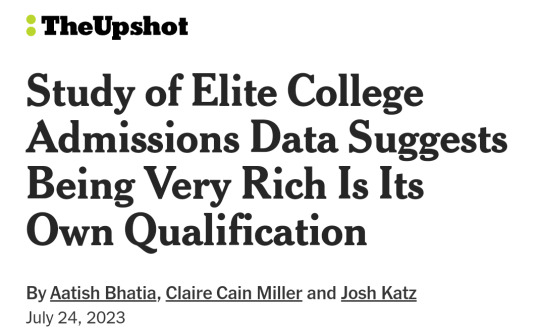


Study of Elite College Admissions Data Suggests Being Very Rich Is Its Own Qualification
By Aatish Bhatia, Claire Cain Miller and Josh Katz July 24, 2023 (full text under the cut)
Elite colleges have long been filled with the children of the richest families: At Ivy League schools, one in six students has parents in the top 1 percent.

A large new study, released Monday, shows that it has not been because these children had more impressive grades on average or took harder classes. They tended to have higher SAT scores and finely honed résumés, and applied at a higher rate — but they were overrepresented even after accounting for those things. For applicants with the same SAT or ACT score, children from families in the top 1 percent were 34 percent more likely to be admitted than the average applicant, and those from the top 0.1 percent were more than twice as likely to get in.
The study — by Opportunity Insights, a group of economists based at Harvard who study inequality — quantifies for the first time the extent to which being very rich is its own qualification in selective college admissions.
The analysis is based on federal records of college attendance and parental income taxes for nearly all college students from 1999 to 2015, and standardized test scores from 2001 to 2015. It focuses on the eight Ivy League universities, as well as Stanford, Duke, M.I.T. and the University of Chicago. It adds an extraordinary new data set: the detailed, anonymized internal admissions assessments of at least three of the 12 colleges, covering half a million applicants. (The researchers did not name the colleges that shared data or specify how many did because they promised them anonymity.)
The new data shows that among students with the same test scores, the colleges gave preference to the children of alumni and to recruited athletes, and gave children from private schools higher nonacademic ratings. The result is the clearest picture yet of how America’s elite colleges perpetuate the intergenerational transfer of wealth and opportunity.
“What I conclude from this study is the Ivy League doesn’t have low-income students because it doesn’t want low-income students,” said Susan Dynarski, an economist at the Harvard Graduate School of Education, who has reviewed the data and was not involved in the study.
In effect, the study shows, these policies amounted to affirmative action for the children of the 1 percent, whose parents earn more than $611,000 a year. It comes as colleges are being forced to rethink their admissions processes after the Supreme Court ruling that race-based affirmative action is unconstitutional.
“Are these highly selective private colleges in America taking kids from very high-income, influential families and basically channeling them to remain at the top in the next generation?” said Raj Chetty, an economist at Harvard who directs Opportunity Insights, and an author of the paper with John N. Friedman of Brown and David J. Deming of Harvard. “Flipping that question on its head, could we potentially diversify who’s in a position of leadership in our society by changing who is admitted?”
Representatives from several of the colleges said that income diversity was an urgent priority, and that they had taken significant steps since 2015, when the data in the study ends, to admit lower-income and first-generation students. These include making tuition free for families earning under a certain amount; giving only grants, not loans, in financial aid; and actively recruiting students from disadvantaged high schools.
“We believe that talent exists in every sector of the American income distribution,” said Christopher L. Eisgruber, the president of Princeton. “I am proud of what we have done to increase socioeconomic diversity at Princeton, but I also believe that we need to do more — and we will do more.”
Affirmative action for the rich
In a concurring opinion in the affirmative action case, Justice Neil Gorsuch addressed the practice of favoring the children of alumni and donors, which is also the subject of a new case. “While race-neutral on their face, too, these preferences undoubtedly benefit white and wealthy applicants the most,” he wrote.
The new paper did not include admissions rates by race because previous research had done so, the researchers said. They found that racial differences were not driving the results. When looking only at applicants of one race, for example, those from the highest-income families still had an advantage. Yet the top 1 percent is overwhelmingly white. Some analysts have proposed diversifying by class as a way to achieve more racial diversity without affirmative action.
The new data showed that other selective private colleges, like Northwestern, N.Y.U. and Notre Dame, had a similarly disproportionate share of children from rich families. Public flagship universities were much more equitable. At places like the University of Texas at Austin and the University of Virginia, applicants with high-income parents were no more likely to be admitted than lower-income applicants with comparable scores.
Less than 1 percent of American college students attend the 12 elite colleges. But the group plays an outsize role in American society: 12 percent of Fortune 500 chief executives and a quarter of U.S. senators attended. So did 13 percent of the top 0.1 percent of earners. The focus on these colleges is warranted, the researchers say, because they provide paths to power and influence — and diversifying who attends has the potential to change who makes decisions in America.
The researchers did a novel analysis to measure whether attending one of these colleges causes success later in life. They compared students who were wait-listed and got in, with those who didn’t and attended another college instead. Consistent with previous research, they found that attending an Ivy instead of one of the top nine public flagships did not meaningfully increase graduates’ income, on average. However, it did increase a student’s predicted chance of earning in the top 1 percent to 19 percent, from 12 percent.
For outcomes other than earnings, the effect was even larger — it nearly doubled the estimated chance of attending a top graduate school, and tripled the estimated chance of working at firms that are considered prestigious, like national news organizations and research hospitals.
“Sure, it’s a tiny slice of schools,” said Professor Dynarski, who has studied college admissions and worked with the University of Michigan on increasing the attendance of low-income students, and has occasionally contributed to The New York Times. “But having representation is important, and this shows how much of a difference the Ivies make: The political elite, the economic elite, the intellectual elite are coming out of these schools.”
The missing middle class
The advantage to rich applicants varied by college, the study found: At Dartmouth, students from the top 0.1 percent were five times as likely to attend as the average applicant with the same test score, while at M.I.T. they were no more likely to attend. (The fact that children from higher-income families tend to have higher standardized test scores and are likelier to receive private coaching suggests that the study may actually underestimate their admissions advantage.)
An applicant with a high test score from a family earning less than $68,000 a year was also likelier than the average applicant to get in, though there were fewer applicants like this.
Children from middle- and upper-middle-class families — including those at public high schools in high-income neighborhoods — applied in large numbers. But they were, on an individual basis, less likely to be admitted than the richest or, to a lesser extent, poorest students with the same test scores. In that sense, the data confirms the feeling among many merely affluent parents that getting their children into elite colleges is increasingly difficult.
“We had these very skewed distributions of a whole lot of Pell kids and a whole lot of no-need kids, and the middle went missing,” said an Ivy League dean of admissions, who has seen the new data and spoke anonymously in order to talk openly about the process. “You’re not going to win a P.R. battle by saying you have X number of families making over $200,000 that qualify for financial aid.”
The researchers could see, for nearly all college students in the United States from 1999 to 2015, where they applied and attended, their SAT or ACT scores and whether they received a Pell grant for low-income students. They could also see their parents’ income tax records, which enabled them to analyze attendance by earnings in more detail than any previous research. They conducted the analysis using anonymized data.
For the several elite colleges that also shared internal admissions data, they could see other aspects of students’ applications between 2001 and 2015, including how admissions offices rated them. They focused their analysis on the most recent years, 2011 to 2015.
Though they had this data for a minority of the dozen top colleges, the researchers said they thought it was representative of the other colleges in the group (with the exception of M.I.T.). The other colleges admitted more students from high-income families, showed preferences for legacies and recruited athletes, and described similar admissions practices in conversations with the researchers, they said.
“Nobody has this kind of data; it’s completely unheard-of,” said Michael Bastedo, a professor at the University of Michigan’s School of Education, who has done prominent research on college admissions. “I think it’s really important to good faith efforts for reforming the system to start by being able to look honestly and candidly at the data.”
How the richest students benefit
Before this study, it was clear that colleges enrolled more rich students, but it was not known whether it was just because more applied. The new study showed that’s part of it: One-third of the difference in attendance rates was because middle-class students were somewhat less likely to apply or matriculate. But the bigger factor was that these colleges were more likely to accept the richest applicants.
Legacy admissions
The largest advantage for the 1 percent was the preference for legacies. The study showed — for the first time at this scale — that legacies were more qualified overall than the average applicant. But even when comparing applicants who were similar in every other way, legacies still had an advantage.

When high-income applicants applied to the college their parents attended, they were accepted at much higher rates than other applicants with similar qualifications — but at the other top-dozen colleges, they were no more likely to get in.
“This is not a sideshow, not just a symbolic issue,” Professor Bastedo said of the finding.
Athletes
One in eight admitted students from the top 1 percent was a recruited athlete. For the bottom 60 percent, that figure was one in 20. That’s largely because children from rich families are more likely to play sports, especially more exclusive sports played at certain colleges, like rowing and fencing. The study estimated that athletes were admitted at four times the rate of nonathletes with the same qualifications.

“There’s a common misperception that it’s about basketball and football and low-income kids making their way into selective colleges,” Professor Bastedo said. “But the enrollment leaders know athletes tend to be wealthier, so it’s a win-win.”
Nonacademic ratings
There was a third factor driving the preference for the richest applicants. The colleges in the study generally give applicants numerical scores for academic achievement and for more subjective nonacademic virtues, like extracurricular activities, volunteering and personality traits. Students from the top 1 percent with the same test scores did not have higher academic ratings. But they had significantly higher nonacademic ratings.

At one of the colleges that shared admissions data, students from the top 0.1 percent were 1.5 times as likely to have high nonacademic ratings as those from the middle class. The researchers said that, accounting for differences in the way each school assesses nonacademic credentials, they found similar patterns at the other colleges that shared data.
The biggest contributor was that admissions committees gave higher scores to students from private, nonreligious high schools. They were twice as likely to be admitted as similar students — those with the same SAT scores, race, gender and parental income — from public schools in high-income neighborhoods. A major factor was recommendations from guidance counselors and teachers at private high schools.
“Parents rattle off that a kid got in because he was first chair in the orchestra, ran track,” said John Morganelli Jr., a former director of admissions at Cornell and founder of Ivy League Admissions, where he advises high school students on applying to college. “They never say what really happens: Did the guidance counselor advocate on that kid’s behalf?”
Recommendation letters from private school counselors are notoriously flowery, he said, and the counselors call admissions officers about certain students.
“This is how the feeder schools get created,” he said. “Nobody’s calling on behalf of a middle- or lower-income student. Most of the public school counselors don’t even know these calls exist.”
The end of need-blind admissions?
Overall, the study suggests, if elite colleges had done away with the preferences for legacies, athletes and private school students, the children of the top 1 percent would have made up 10 percent of a class, down from 16 percent in the years of the study.
Legacy students, athletes and private school students do no better after college, in terms of earnings or reaching a top graduate school or firm, it found. In fact, they generally do somewhat worse.
The dean of admissions who spoke anonymously said change was easier said than done: “I would say there’s much more commitment to this than may be obvious. It’s just the solution is really complicated, and if we could have done it, we would have.”
For example, it’s not feasible to choose athletes from across the income spectrum if many college sports are played almost entirely by children from high-earning families. Legacies are perhaps the most complicated, the admissions dean said, because they tend to be highly qualified and their admission is important for maintaining strong ties with alumni.
Ending that preference, the person said, “is not an easy decision to make, given the alumni response, especially if you’re not in immediate concurrence with the rest of the Ivies.” (Though children of very large donors also get special consideration by admissions offices, they were not included in the analysis because there are relatively few of them.)
People involved in admissions say that achieving more economic diversity would be difficult without doing something else: ending need-blind admissions, the practice that prevents admissions officers from seeing families’ financial information so their ability to pay is not a factor. Some colleges are already doing what they call “need-affirmative admissions,” for the purpose of selecting more students from the low end of the income spectrum, though they often don’t publicly acknowledge it for fear of blowback.
There is a tool, Landscape from the College Board, to help determine if an applicant grew up in a neighborhood with significant privilege or adversity. But these colleges have no knowledge of parents’ income if students don’t apply for financial aid.
Ivy League colleges and their peers have recently made significant efforts to recruit more low-income students and subsidize tuition. Several now make attendance entirely free for families below a certain income — $100,000 at Stanford and Princeton, $85,000 at Harvard, and $60,000 at Brown.
At Princeton, one-fifth of students are now from low-income families, and one-fourth receive a full ride. It has recently reinstated a transfer program to recruit low-income and community college students. At Harvard, one-fourth of this fall’s freshman class is from families with incomes less than $85,000, who will pay nothing. The majority of freshmen will receive some amount of aid.
Dartmouth just raised $500 million to expand financial aid: “While we respect the work of Harvard’s Opportunity Insights, we believe our commitment to these investments and our admissions policies since 2015 tells an important story about the socioeconomic diversity among Dartmouth students,” said Jana Barnello, a spokeswoman.
Public flagships do admissions differently, in a way that ends up benefiting rich students less. The University of California schools forbid giving preference to legacies or donors, and some, like U.C.L.A., do not consider letters of recommendation. The application asks for family income, and colleges get detailed information about California high schools. Application readers are trained to consider students’ circumstances, like whether they worked to support their families in high school, as “evidence of maturity, determination and insight.”
The University of California system also partners with schools in the state, from pre-K through community college, to support students who face barriers. There’s a robust program for transfer students from California community colleges; at U.C.L.A., half are from low-income backgrounds.
M.I.T., which stands out among elite private schools as displaying almost no preference for rich students, has never given a preference to legacy applicants, said its dean of admissions, Stuart Schmill. It does recruit athletes, but they do not receive any preference or go through a separate admissions process (as much as it may frustrate coaches, he said).
“I think the most important thing here is talent is distributed equally but opportunity is not, and our admissions process is designed to account for the different opportunities students have based on their income,” he said. “It’s really incumbent upon our process to tease out the difference between talent and privilege.”
Source: Raj Chetty, David J. Deming and John N. Friedman, “Diversifying Society’s Leaders? The Determinants and Causal Effects of Admission to Highly Selective Private Colleges”
193 notes
·
View notes
Text
I posted this on X, and I feel kind of disloyal not saying anything in here, since I feel Tumblr as my main online residence.

I would like to expand here, where I feel safest, if you let me.
As I said, I'm not a writer. Not a talented one, at least. Maybe I could be if I work hard enough, but I have little free time and I have to diversify it since I've got plenty going on. I don't have like, the busiest life, but I work full-time and I have a little family, and friends, a dog and a house to keep. And when I'm not doing all of that, among all my personal individual hobbies, drawing is what takes most time.
And drawing--well, I can't draw a fanart without romanticizing the process. There is no fanart without a back story that I've got in my mind, that I always fall in love way too deep with it, and always have the intention to put into words, but English is hard for a non native speaker, and even harder for a impatient perfectionist. So it takes a lot of time and I am never satisfied with the results, which is massively disheartening.
So after more than a year making this fandom my home, and with, idk, twenty, thirty fanarts, that means that there are twenty or thirty stories that I've got safely and preciously stored in my heart that I barely shared with anyone.
I mean full fanfics, from beginning to end, maybe with a few loose strands that needs revisiting, but overall, completed stories. And I know I'm biased here, telling you that I love them, and maybe they're not good, but I do love them. I'm a romantic. Some of them explore the concept of home, or tropes like "the one that got away", or the survivor guilt, or keeping the balance between being who you are and acknowledging that you're wrong and rewiring some things. Some are just funny AUs, fluff or smut (I can't write smut for SHIT), some more basic, some not. Some are not even steddie.
But I love all of them, and I can't write them and they're dying with me.
So I've been thinking for a while, that maybe there is a writer out there that wants something to write but can't find inspiration, or a theme to talk about and if that's de case, and you feel like it, you can DM to me, that I will give you the whole idea, everything that I worked on and pass it on, so you can have an idea to work with.
It feels so silly being so absurdly emotional with this, since, well, it's just stories, I guess, about things and people that don't exist, and maybe they're not even good or worth to work on because it may be better works out there that treat those subjects more brilliantly, but I love them and they're important to me and if I don't do this, they're dying with me and I think that maybe those silly ideas deserve a chance.
So, well, yeah, if you are a fic writer that is looking for something to write about, you can reach me. Maybe we can help each other out.
Thank you for taking the time to read all this nonsense 💖
77 notes
·
View notes
Note
Marc’s shows varied in quality and reputation of venue, all what he claimed was ‘diversifying his range’. From standard stages in bars, underground speak easies that were subject to police raids at least twice a week, and classier gigs he needed a new suit each show. Grasping a semi regular gig in another bar, it’s the first time he’s been hesitant to let Oliver see it. They were nearing three years, but this one performance has a new air of secrecy to it.
A note with the address is dropped in one of his textbooks, a kiss to his lovers temple before he leaves for the performance.
“Don’t ask anyone what’s happening here, don’t tell anyone you’re going here. Sit in the third seat to the left, the table as a big ugly lamp beside it.”
Most of the bar is quiet, conversations kept to themselves at all times. Marc is no where to be seen, no invite extending to see him in the dressing room. A tiny piece of paper is on each of the tables, brief programs of the nights variety act. Fake names, not one of them Marc.
@snakedifferentskin
Oliver has been to Marc’s shows before. Even before they’d established the underlying feeling in their relationship, he was always there to support him in everything he did. However, none of his shows were usually this… secretive? Was that the correct way to describe it? As he seats himself down at the corresponded table and rereads the instructions left for him, perhaps secluded would be correct as well.
Slipping the piece of paper back into the pocket of his coat, he briefs over the programs and names listed, discreetly looking over his surroundings. If Marc wasn’t in the show, would he be meeting him here? It would be the first time they’ve attended any social event alone, with just the two of them as company.
Except with no sign of Marc at the table or on the tiny list of programs, he’s left with only his thoughts as company for the time being. It was harder to pass the time without Marc to fill the silence, but he could make do. The distinctively ugly lamp keeps his attention for now.
56 notes
·
View notes
Text
so, apparently marvel is in disarray. ahead of the marvels coming out this weekend, variety dropped a bomb on the studio's somewhat dire state of affairs, as the franchise has hit its first real rough patch since the release of iron man 15 years ago. among the issues: jonathan majors, whose domestic violence arrest continues to hang over marvel's plans to make his character the thanos-like heavy for the next sequence of movies, the weak box office projections for the marvels (which some have said is tracking lower than recent bombs like the flash), the unending flood of hashtag content on disney plus which is overwhelming audiences who are finding it harder to keep up with the interlocking stories that have served marvel so well over the years, shoddy visual effects, spiraling budgets such as the reported $25mil an episode for she-hulk, a show that looked terrible because of the shoddy effects work aforementioned, behind the scenes chaos as kevin feige works to slash budgets and kill projects that aren't coming together. one movie at risk is the forthcoming blade reboot with mahershala ali, which has gone through rewrite after rewrite including reportedly one draft in which blade was the fourth lead in, quote, "a narrative led by women and filled with life lessons".
that last line has provided a lot of laughs for people like jay gothicprep, and critics who insist that marvel's efforts to diversify the lineup have led to much of this disaster, indicative of disney's overall failure with things like indiana jones and the dial of destiny or animated projects like strange world or lightyear. while this is potentially true (i guess, it's possible) it doesn't seem true because this certainly wasn't the case when black panther and captain marvel were both cracking the billion dollar mark a few years ago. rather it just seems, more simply, that marvel has run its course. marvel was hit by a double-whammy of endings. the thanos storyline that'd dominated the first ten or so years of the project came to an end. at the same time, the pandemic began and disney plus started flooding the zone with content, creating a natural break point for audiences that had no desire to watch hours of tv to understand 1.5 plot points in whatever the next movie that's coming out is.
this preamble is getting kind of long, and i have a lot more to say, so i'm going to continue to thought dump about this under a cut.
first of all, i'm still laughing like a week later at the women led life lessons description. no one has disputed that it happened. that description is the funniest thing i've ever read in a trade industry report possibly ever. what in the hell, my friends. did a writer even talk to a producer about what blade was? it's a movie about a guy with a sword who kills vampires! it's pretty straighforward! that sounds like something i want to see! there were three of them already, and two of them were pretty good!
anyway, i think you can take that incredibly ridiculous description of a draft that maybe wasn't the main draft – this movie has been through tons of writers and directors – and see some of the real problems with marvel's creative direction, which is that they've stopped making movies that highlight the core concepts of their characters. there are other problems as well, but when's the last time they put out a movie that was like, "iron man. he's a guy in a metal suit and he fights a bad guy." or "spider man. it's a guy in a spider suit with spider powers. he's got girlfriend problems and he fights crime around manhattan and maybe there's dr octopus." they don't do that. their recent stretch of movies have all been these impenetrable multiverse stuff with ties to tv series that you haven't seen and maybe won't ever see. there was a whole 25 minute section in black panther 2 that was setting up armor wars and ironheart. and like. who needs that sequence, which was boring and looked like total garbage? and now armor wars is being redeveloped lol. they've just departed from a lot of the core concepts that powered their earlier films.
they have some other problems. they've leaned into a slate of characters that is not all that well-known or inherently super popular, even for marvel being able to deliver on making billion dollar films out of guardians of the galaxy and such. maybe with the exception of spider man, which they don't get a full cut from because sony owns the actual movie rights. then there's the fact that the streaming series, by all accounts, aren't great but you *feel* like you need to have seen them. they're all real big problems. marvel needs to go back to making movies that are named after a character who's a superhero with a clear concept. guy with spider powers fights crime in his neighborhood. even though those movies got kind of repetitive, they did well enough because they didn't stray too far from the character concept.
i think, too, as a viewer, when you have a studio churning out so much stuff that's not good, you get the impression that the superhero industry feels entitled to your time and entitled to your money while not delivering.
this summer also represents an interesting counterpoint to what's happened with marvel and dc. the sheer amount of stuff that you devote every waking minute to keeping track of the damn things got exhausting and made movies stop feeling like events. this summer we've had barbenheimer and the eras tour, and those have been both big events and felt exciting. barbie was a chance to be campy, oppenheimer was a chance to see something serious and cinematic, the eras tour was exciting for fans of taylor swift who couldn't afford to spend $3k on taylor swift. and they felt this way because they were all unlike anything you'd seen at the movies in recent years. they had a high standard of quality, and going, it genuinely felt like people were there because they wanted to be, not because they were being force marched by a cultural behemoth to be there. you can't summon that same kind of energy for a marvel movie when it both feels obligatory and you expect it to be bad.
it also feels like there's a certain contempt for the audience where it concerns quality problems. i mean, i don't think that this is the intention. marvel isn't saying "we can deliver this stuff that's garbage and people will see it anyway". but one of the things i thought was the most damning about that variety story was the fact that, on some of the marvel tv shows, the final effects were inserted after the shows were released. so if you watched the show on opening night, you probably didn't see the final effects work. the arrogance involved in that is insane. it speaks to a total vanished pride in putting out a good product.
even some of marvel's better regarded films were heavily edited and heavily worked on right until the end, in part because kevin feige would come in and fix things, so stuff would have to get reworked. that's why effects deadlines were super tight and people were always crunching at the very end of this. there was that incredible quote from sam raimi from a couple months before the second doctor strange came out where he was like, "i think it's done but i'm not sure. marvel, they work on their movies until the very end." the director didn't even know if his own movie was locked or not because he clearly wasn't the one making the decisions about what the final print would look like.
that can work if you're making two movies a year and have a supervisor that comes in during the process and says, "i need you to redo this, in this way". but when you stretch that out to three movies a year, plus god knows how many episodes of television, there's no way to do that and make it a high quality product.
an instructive lesson comes from the book "disneywar", which chronicles michael eisner's time at disney. and one of the things in this book was the development and deployment of "who wants to be a millionaire" in america. bob iger is head of abc at this time. the guys making this show do it for a week. audiences love it. it's putting up huge numbers. everybody is excited. it's crushing it in the ratings. and the people who made it wanted to keep doing special week or two week long engagements that people would show up for. and iger was like, "no. i want this every week, three times a week, forever." and audiences got burnt out on it quickly, because it was something that only really worked as a special that ran for a week and disappeared for a few months. that's what the disney plus strategy feels like with marvel.
65 notes
·
View notes
Note
For the beginners and champions of each sport (most specifically, Cole and Lucía, but it's open to all of them):
How well do you get along? Champions, have you given any advice to the beginners?
Cole: Me and Lucia? Oh yeah, we get along very well actually! Even though I’m not that good, she helps me practice a lot!
Lucia: Indeed! Practice is key, and I try to make him return harder shots by trying out different hitting techniques! Improvement is slow but… I’m sure he’ll get better while I do the Return Challenge with him!
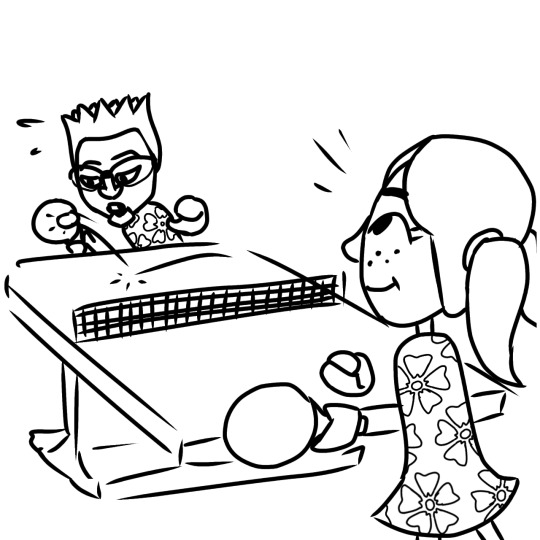
(also gonna do for the others because it's a real interesting question XD also cool extra lore, coughs... all are under the cut since the post is kinda long ig)
Ryan: You’d be surprised that both me and Matt are on really good terms. Friends even, despite me sucking at both of his best sports.
Matt: I taught Ryan the rules for both Boxing and Swordplay, and let him practice with me in friendly matches. I trust him to be a really good referee, and in the meantime I get to teach him some of the best strategies for him to try. And most importantly: determination!

---
Miguel: Tommy? We don’t speak much, but I’m a big fan! I’m afraid I won’t be at his level in this sport, but perhaps while watching him and his team play our team might learn a trick or two…
Tommy: I guess I haven’t really approached Miguel much because I’m so focused on talking to Eva and Tyrone… However, if he needs advice, I’d say to not just work on the shooting, but the dribbling as well. Learn how to get close enough to the basket before the opponent snatches the ball, and you might get some easy hoops!

---
Naomi: Oh yeah, even though I’m not good in Cycling, I’m still good friends with Anna! We usually talk it out at lunch or something, she may be intimidating at first but she’s actually really nice!
Anna: Definitely! And my advice would simply be to go with the flow! I tend to like going on a nice bike ride with friends, so Naomi gets to join along when she can!
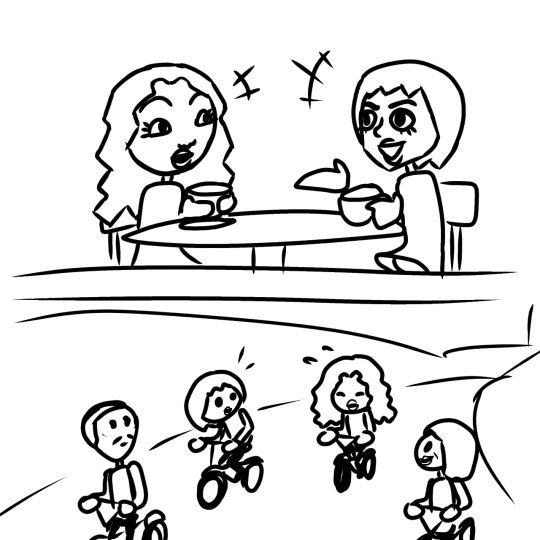
---
Hiroshi: In all honesty… none of us really want to interact much with Elisa and Sarah. I-I mean… look at them!
Shouta: We’re all a bit terrified of them, that’s for sure!
Sarah: I’ve told the players time and time again! Keep playing tennis and keep trying, that way you’ll get more confident! Ah… Elisa, any other advice you’d like to make?
Elisa: …………… keep practicing.
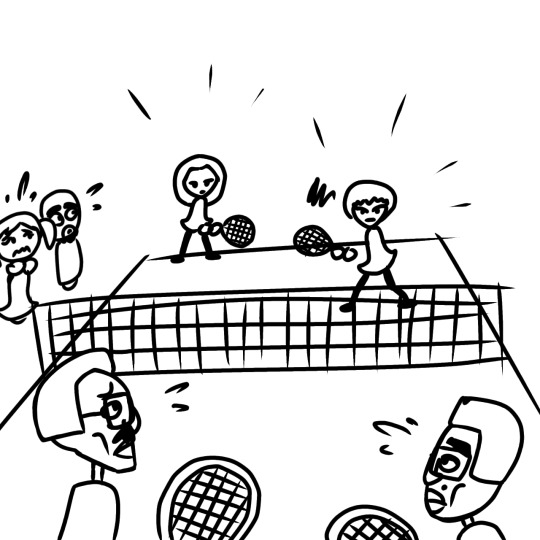
---
Elisa: Sakura? ………… she’s fine I guess…
Sakura: Oooh yes yes, I talked to Elisa a lot! I try to teach her different throws, batting skills, and running… Oh! But the best advice for her studious mind is to diversify her shots! But of course, all due in time, she needs to get the key components first! :3
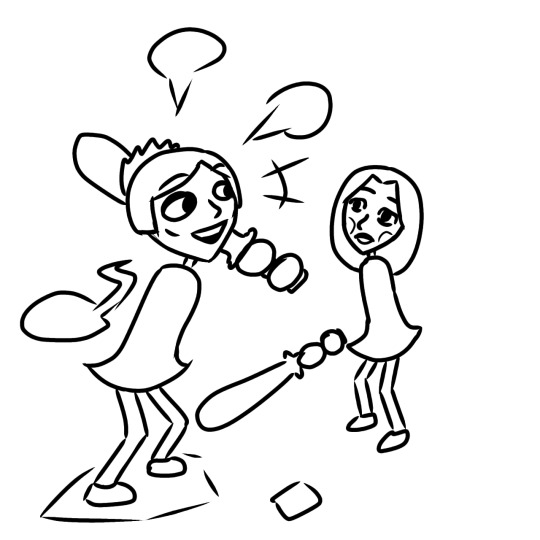
#ask the miis#ask#mii#miis#game on#wii sports#wii sports resort#wii sports champions#thanks for the ask!#also yeah imagine my surprise finding out again that Elisa and Matt are technically beginners in other sports than their faves lmao#but almost everyone are friends!#ALMOST being the key word#and sorry it took a while as well#but i HAD to ilustrate those guys together
23 notes
·
View notes
Text
Okay, now is the time where I complain of Duo's arc (I don't know if I'll ever do this again)
[Spoilers for Idw Sonic #62, #63 & #64]
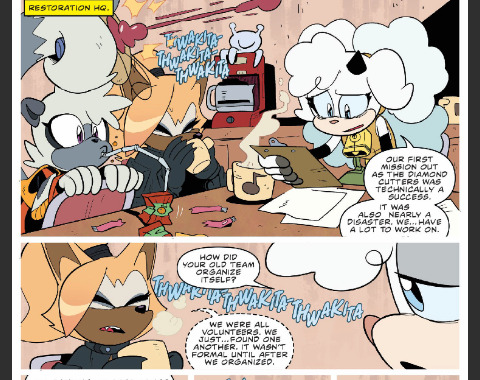
This is where everything starts, the Diamond Cutters talking about their lastest, and also very first, mission as a team...
I will already point something: Note that Lanolin says "We have a lot to work on 😑😮💨" instead of "We have a lot to work on 😖😩" Yep, the emojis are important.
My point is that the face she actually does indeed gives the vibes of someone tired who wants their team to get better... Buuuuut, it doesn't show her dissatisfaction with herself, if she showed herself a little more panicked and vulnerable in front of her teammates, she would more definitively give the vibes of someone who is pressing herself above all else, who is stressed because she takes her and as primarily her own fails as a leader and intend to work on.
This could make us reconsider her actions towards Tangle and her toy:
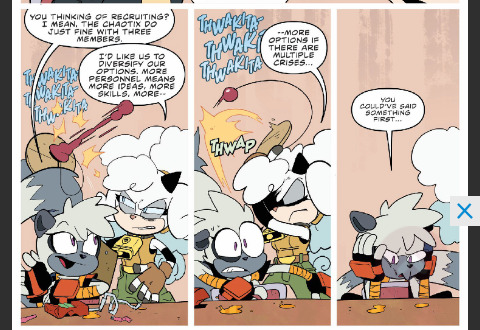

Note that since she looks tired on the start but only seems irritated when glaring at Tangle, she seems not to be taking the a bigger portion of the fault to herself, what would bring the point of she being pressing herself more than the rest of the team and so tending more to give slight bursts like this with Tangle's toy... But since she doesn't show such signals and given she's looking at Tangle and her toy with irritation when she is also talking about "diversify the team" and "have more options" it lend the readers to think she's got some beef with Tangle. It comes out more as rude attitude towards an already established character than as some burst of somebody being pressed (either by somebody else, either by herself)
That got too much, next point: Duo's arrival
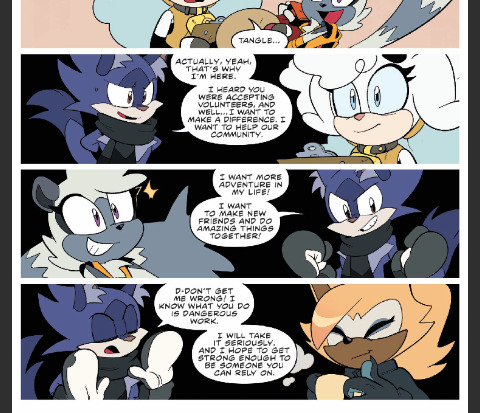
Mimic is clever, he strikes the right points to convince them three that he is determined to help, willing to evolve and not afraid of the stuff he KNOWS are dangerous, so their acceptance of this new member happens just good.
And then we got what is the WORST decision in the plot of this arc:
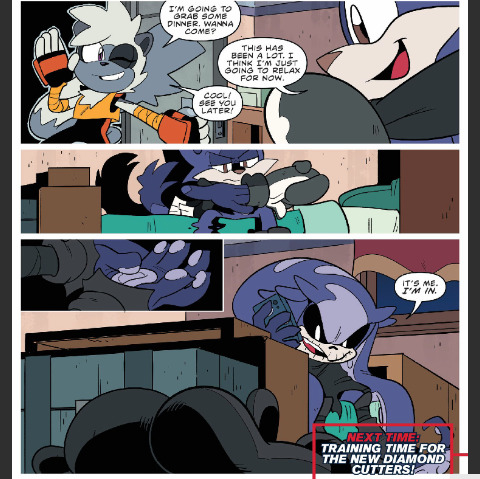
They reveal us it's really Mimic in the EXACT next page after he is accepted just like that. No mystery... no red herrings... they just show us that...
If they kept this twist, we could give Lanolin more credit later when she gets in the recruit defense, but well... We know she's wrong, then it's harder to understand.
But now they showed that to us, they'll showcase Mimic's disguise abilities and his ellaborated lies and plans, right?
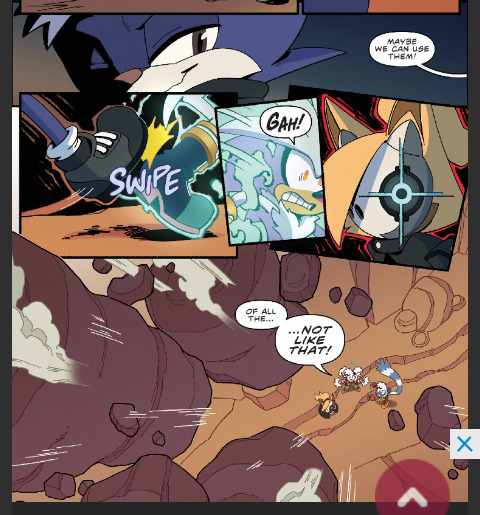
Mimic's "ellaborated" plan is kick Silver and expect the following rock slide to kill the DC, after all is not like they were fast and quick enough to avoid that or had resources to explode the rocks and protect themselves, right?
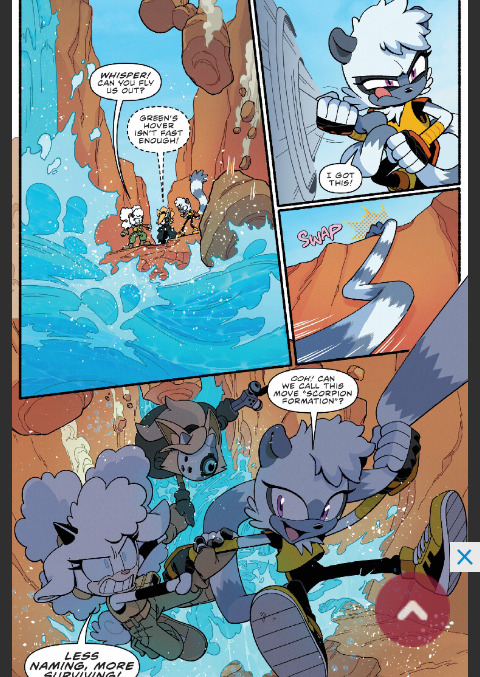
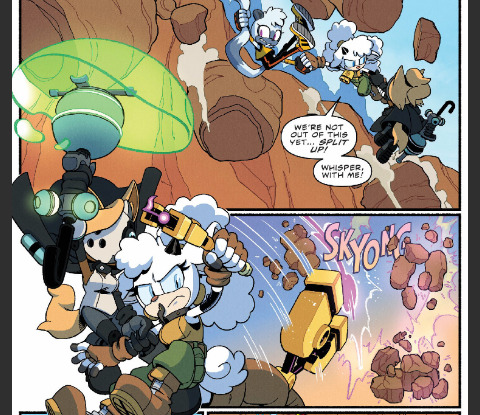
OH, wait, they HAVE, they CAN and they DO!! they avoid AND explode the rock slide quickly, right? WHAT A SURPRISE, NO??
Sarcasm aside, Mimic's plan was full of holes, like Whisper was the only one to see he kicked Silver... But he was really expecting Silver didn't feel that? And if the rocks smashed the DC, what would he do? Reveal himself to Silver since the hedgehog would not have ways to prove? Worse: What if Silver managed to grab the rocks again? What would he do?
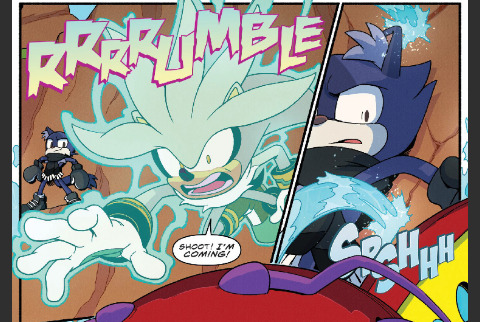
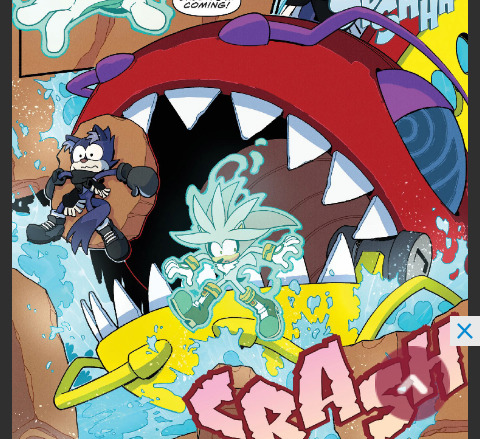
Oh wait, he luckily doesn't have to worry about that since this flood and Giant Chopper comes out from nowhere and make sure Silver is not able to help the DC and give them a badass moment in which they show they didn't need to move at all if weren't the flood, Lanolin's magenta wisp easily destroys the rocks as well as Whisper's rocket would...
I reached the 10 photos limit, pt 2 in reblogs:
#silver the hedgehog#sonic the hedgehog#whisper the wolf#mimic the octopus#duo the cat#Lanolin the sheep#tangle the lemur#idw sonic#idw sonic spoilers#idw Sonic 62#idw Sonic 63#idw sonic 64#one-half-guy complaining
43 notes
·
View notes
Text
i have been thinking about the evanuris so much since that trailer dropped. this is gonna be rambly, long, and kinda heavy
i dont find criticizing the things i like to usually be very useful or good for my overall mental health, but seriously, im still very, deeply upset with the way dai handled the evanuris. i wish they had gone almost any other direction. making the extremely oppressed dalish's gods into a) not gods and b) actually awful slavers! is like. well. points for finding the most fucked up path forward and dedicating yourselves to it, i guess
bc of that, i can't help but hold out a sliver of hope for a bit of a retcon with da4. i'm not talking issues of likelihood or implication here, just desire and the fact that retcons of standing game canon are obviously possible. it's happened a number of time - solas dropping the big Actually The Evanuris Are Monsters thing on us was one of the bigger retcons of everything we'd ever learned about the creators, in fact
and if they don't change the slavery aspect entirely, i want them to at least... idk how to say this. diversify opinion on it within the evanuris? make it more complicated? the evanuris are presumably at war with the forgotten ones and the titans. could they also be at war with themselves?
how old is their history of slavery? how did it begin? why wait for fen'harel's rebellion to address it? who's telling the story of the evanuris? the dread wolf? obviously i love solas but i'd honestly rather see him as a liar and a bad guy who twisted the whole thing and the evanuris as the creators. or maybe he's just someone who doesn't remember things as clearly as he thinks he does, someone for whom his "millennia of dark, dreaming sleep" distorted his recollection of arlathan
flemythal is obviously fucked up. there's theories about her being a spirit, or part-spirit, theories i've also entertained, in which case i could see her being justice -> vengeance. maybe becoming vengeance is what made her 'bad' - like being abusive to morrigan, possibly sorta grooming kieran, etc. but during arlathan, was she the only 'good' evanuris? are they all irredeemably evil? i hate irredeemably evil arcs. i don't want every villain to be redeemed, either, that's not my point at all, but i hate the You're Evil-Bad And Obviously Can Never Change arcs. i hate black and white dynamics like that.
it's messy af to make slavers sympathetic. they managed decently with dorian - he grapples with the reality of the situation he was born into and never had cause to question, and comes out the other side with a changed opinion.
idk what i want. i want to give the dalish people their gods back. i don't want their hard-won and harder-maintained faith to be usurped by such an ugly reality. i want to redo the ending of trespasser to make it that the Maker is real and just a massive piece of shit. that'd be fine.
and if they can't retcon it, i want some of the evanuris - idc who, rly - to be opposed, to have grown, to return in humility to the dalish who have spent all this time honoring them. not as gods, but as people. if they can't have their gods, let them have the reality of those 'gods' working towards something better than their grim history. let dalish wear their vallaslin with pride instead of calling it a naive attempt to clutch at the branding of slavery. ugh. it's just so ugly and complicated i hate it.
#broodmeta#bioware critical#evanuris#sighs forever#okay im done with the critical posts for tonight i just needed to get this off my chest#i love these games i do but...#sometimes they make rly bad choices. like. RLY bad choices.
12 notes
·
View notes
Text
Introducing The Rainbow Book Club
Introduction
In its bid to listen to fans, Storygraph has finally allowed for Book Club and I think it's great as it brings a bit more community into the app. This has been a long time over due and I'm absolutely buzzing with excitement.
For those who don't know advocating through reading is a huge passion of me. I'm a 100% on the train of trying to diversify your tbr and as a queer person I've felt it especially important to get queer literature out there. I've set up an Lgtbq+ Book Club at my college and hopefully at my university. Its a way to have a space for people to explore different queer books and find ones they might not even be aware of.
Its been fun running an in person Book Club so I knew I wanted to do one online so let me introduce you too...

What Is The Rainbow Book Club?
Under a much better name then Lgtbq+ Book Club, The Rainbow Book Club is going to be an online Book Club open to everyone that will focus on reading and discussing Lgtbq+ Books. All books will be books that are labelled as and include Lgtbq+ representation.
The goal of this book club is to get people to essentially read with pride and each month on the Storygraph a poll will go up so that people can vote for the queer book they want to read. Unfortunately it'll have to be queer books I've read as it's harder to do an online Book Club without having read the book.
It'll run entirely online with this year's sessions being sometimes on tik tok live whilst other times zoom. From January 2025 though all book club discussions will be hosted on my tik tok live. Depending on circumstances as I'm aware America is potentially gonna have the app banned all together. I'd love to do zoom but I think larger numbers are more likely to be on live streaming.

When Will The Book Discussions Take Place?
All Book Discussions will take place on the last Sunday of each month from 8:30 GMT in order to give non UK folk a chance to join if they want too. So for example May and June's meetings will take place on the 26th and then the 30th. Unless I get ill or promptly too tired or something comes up, I intend to stick to the schedule.
I'll also be hosting readalongs on the side of Storygraph for anyone who just wants to take part on the reading side and not the discussion part.
For the first meeting we will be discussing Pageboy By Elliot Page. I thought I'd be best to starting with a queer book I've recently read in order to refresh the mind. On the 26th of May I'll be hosting a live stream discussion about Pageboy on my tik tok @fierymelody and will invite those to take part in the discussion on screen if they wish to be part of the live. I'll last from an hour as I won't be constraint by not paying for zoom.

Conclusion
I'm very excited to have set this up and I hope that it can evolve and gain more members once I've got into the flow of things better. Pageboy and Loveless are the first two picks and I'm excited to get many more after June's ended. Although the polls are still gonna consist of books I've read I'm sure the discussions are gonna be super interesting. Won't spoil but I certainly have some interesting thoughts about Pageboy.
I hope things go well and I'm gonna try get my tbr more diverse so that there's more diverse poll choices. I'm very excited to get this started. I've also made rules banning problematic authors and I'm gonna do my best to stick to that. Hopefully despite starting uni this year I can make things work. I'm really looking forward too it.
I'm sorry to say but after having both Storygraph and Goodreads, Storygraph has way better visually looking book club page. Now book clubs are here I hope it gets Storygraph haters quieter about the fact it had no social connections but now it does.
I use both but prefer Storygraph.
For those interested see you May 26th.
-Melody-
They/Them

#storygraph#book club#bookish#bookworm#booklover#book tumblr#bookblr#lgtbq community#lgtbqia+#lgtbtq#own voices#queer representation#queer authors#pageboy
4 notes
·
View notes
Text
Prestige Class Spotlight 12: Ashavic Dancer

(art by Arshi Sy on Artstation)
The image of the lone dancer in the moonlight is a simultaneously serene yet eerie trope, and today we’re tapping into a bit of that with today’s entry!
Named for the Empyreal Lord Ashava (whom we will do an entry on in Deity Drop eventually), who dances to lead the lost home, especially lost souls, today’s subject seeks to emulate their patron by seeking out the restless dead and helping put them to rest with dances of their own.
Some may be bards, while others might be clerics, oracles, and the like devoted to the azata demigod, and others still might belong to other professions. Regardless, however, they are devoted to helping the dead rest and the living find their way.
As we’ll soon see, the moves of these mystical dancers are more than just for show.
Naturally, the prerequisites for this class involve being able to cast spells, being a proficient dancer, and having an affinity for communicating with spirits.
This prestige class has similar roots to a bard, and indeed they gain their own performances, and can even tap into any bardic levels to fuel them as well.
The first such performance saps the motivating force from undead and haunts, slowly fraying their spirits as long as their dance is visible to them.
They can also choose to debilitate the undead instead, weakening them.
Another dance lets them affect all within with healing magic that heals the living within while also withering the dead.
Moving on from those that simply damage or debuff foes, they also eventually learn a waltz which can force possessing spirits out of a victim or simply break normal mental control as well.
The most powerful among them are able to perform a dance which coaxes the dead back into the graves in an almost literal way. Undead subjected to this supernatural performance are rendered sluggish and severely weakened as their ties to this world are severed, and this power is even harder to resist if either the place where they died or a consecrated grave are nearby, the call of final death and repose beckoning them.
Of course, these performers are more than just their performances, though importantly they learn the rituals to bridge the gap between living and dead, so that their performances can affect the undead, which extends to their mind-affecting magic as well as long as they perform the right ritual dance moves beforehand.
Like a bard, they can also learn to utilize their dancing skills in place of other types of skills as well, and even learns to apply them to even more skills later on.
Additionally, while they dance, the magic of their performance lets them reach into the ethereal, blessing their weapons and spells to strike the incorporeal without error.
Whether you go bard, cleric, oracle, or perhaps another class, this prestige class offers a lot of fun counters to incorporeal and otherwise undead foes, and even has elements that work upon haunts as well. If you’re playing any sort of character with a decent charisma, you can probably make use of the class if you plan on going undead-hunting. That being said, you do need at least some spellcasting, so splitting levels further with another multiclass is doable, but be sure to choose something you can dip into nicely, such as swashbuckler, rogue, or fighter. Heck, even sorcerer is a good choice. However, remember that your abilities from this class only really work on the undead, so I recommend using the feats and spells you get from your levels to diversify so you’re not overspecialized to the point of being unable to fend off living foes.
Something that is important to remember about this prestige class is that one of the prerequisites is a feat that literally lets you talk to the dead, both inert corpses and haunts. With that in mind, the charisma of these characters can come into play with more than just slaying undead, but speaking to them, helping them find a way to be put to rest. With that in mind, these dancer likely have a caring and understanding attitude towards the wayward dead.
Hailing from a nocturnal people, it only makes sense that the syrinx mystic Asheda has devoted herself to the faith of the Night Dancer, one who performs the elegant dances to soothe the dead and destroy those that refuse to rest. While she is beloved by her people, she holds a secret: she has fallen in love with one of the wingless.
They say that Vosven Hold is haunted, though no priest has been able to exorcise it. It takes the coming of a spirit dancer, versed in occult lore, to realize the truth, that the haunting spirit is no lingering dead, but a rare kami spirit called a dunagh. Distraught that the family line that once dwelled there has ended, the spirit has tormented visitors ever since. The dancer may be able to convince them to seek a new ward, but in the meantime, the party must fend off an attack from monsters of the wilderness!
When the Deathless King came into power, one of his decrees was to forbid all dancing. As over the top malicious as it seems, this did serve a purpose of criminalizing the art of spirit dancing, in hopes that such mystics with their ability to put the undead to rest could not use their power against him.
13 notes
·
View notes
Text
Enantiornithean Earth
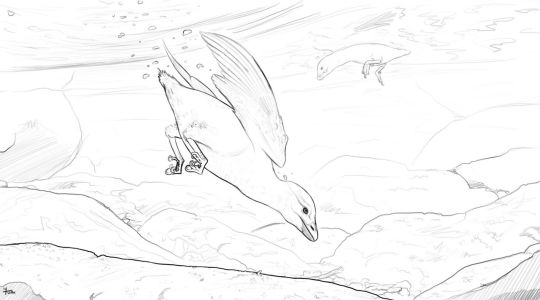

Yungavolucris and Halimornis by midiaou and xenopleurodon respectively. Both are real life Cretaceous taxa, showing that these birds were already diversifying into aquatic ecologies.
Enantiornithes are a group of extinct flying theropod dinosaurs that you could reasonably call birds, being the sister group of Euornithes (the group that includes modern birds). However, they differ from our birds in a variety of ways (their name literally means “opposite birds” for a reason):
Several skeletal details, including a tarsometatarsus that is either unfused or half-fused (beginning at the top rather than at the bottom, the opposite than in modern birds), an articulation of the scapula and coracoid that is oppositely shaped (hence the name; the coracoid joint is convex and the scapula joint is concave shaped in enantiornitheans, while the opposite happens in modern birds), a shallower sternum keel with bizarre antler-like projections (which, combined with large crests in their humerus, suggests the muscles lifting the wing were attached to the back as in bats and pterosaurs, rather than all flight muscles being attached to the keel as in modern birds), and a large, rod-shaped pygostyle (which will be relevant later).
Usually toothed jaws instead of beaks, though some taxa did become toothless. Even then, these weren’t capable of cranial kinesis like modern birds (i.e. watch a duck or your pet parrot yawn and you can see them moving their upper jaw; enantiornitheanss are many things but they’re not that abominatory).
All known taxa thus far seem to have been superprecocial: ample sites show buried eggs like those of megapodes, and the hatchlings were already fully flight capable soon after birth.
Unlike modern birds, enantiornitheans lacked a tail fan. They either had contour feathers on their butt like in the rest of the body or had long, streamer-like display feathers, also found in other Cretaceous bird groups but not in modern birds. Some species did have retrices, but they were arranged along the rod-like pygostyle and were not a movable fan, so essentially they were a variation of the tail fronds seen in Archaeopteryx and kin. Note that this did not make flight harder; even modern birds can fly reasonably well without a tail.
Why the opposite birds died out at the end of the Mesozoic while ours survived is unclear. Often, a bias towards arboreal niches is cited, as many enantiornitheans were in fact arboreal, but as the examples above show they also occured in marine and terrestrial niches alongside the ancestors of modern birds. Another possibility is their supreprecocial habits, meaning a more complex ecology as the birds matured since they were already functionally independent since birth, and this did hinder reptiles like lizards so the answer might lay there.
Or, most likely, it was just dumb luck.
Anyways:

Senmuruy hvare by Dave García. A four meter wingspan predator vaguely analogous to the golden eagle and cinnereous vulture, soaring across the northern hemisphere for corpses to dig its long snout into or live mammals and birds to sink its talons into.
Many Cretaceous enantiornitheans were already suspected of being raptorial, so it is only natural that, once pterosaurs were gone, they’d increase in size. Some reach wingspans of fiver meters, but most are more moderately sized at 1.5-3 meter adult wingspans. Smaller sizes are handled by the young, which like all enantiornithes can already fly since birth and occupy distinct ecological niches. Most species protect the nest and moderate its temperature like our megapodes, and a few even display mild parental care, allowing the young to remain in the vicinity until they’re large enough to be competition.

Euodontopteryx anatosuchus, a six-meter wingspan pelagic soarer that occurs in tropical and temperate waters, using its massive wings to ride on thermals like frigatebirds while landing to feed like albatrosses. Males sport streamer-like display feathers. By Dave García.
As noted above, some Cretaceous enantiornitheans were already aquatic, so this trend continued. Some species became divers, mostly wing propelled and some even flightless like our penguins, while others inversely invested in supreme gliding abilities, able to either ride thermals like frigatebirds or wave winds like albatrosses.
The most impressive species are reccord beaters. Divers can be as tall as a man when on land, while soarers can reach wingspans of over 7 meters, competing with flying multituberculates for largest living flying animals. Both groups tend to have long, toothy maws, the teeth alloted into a single row rather than individual sockets; this condition is known in both extinct sea birds and reptiles as well as some living cetaceans, and is known as aulacodonty.

Ghaltavis rex, a three meter tall predator that stalks African and Asian savannas. An apex predator of its own right, an echo of the distant unrelated tyrannosaurs in the form of a bird. By Dave García.
At least one real life enantiornithean, Elsornis, appears to have been flightless. It’s descendents were quick to occupy roles previously taken by non-avian theropods, from ratite-like herbivores to formidable predators that look like the fusion of a terror bird and a tyrannosaur, using their powerful jaws to crush bone.
The relatively long enantiornithean pygostyle allowed them to balance their pelvis/femur joints (a known size inhibittor in our birds) and grow to sizes larger than our timeline’s birds, though species above a ton are fairly rare seeing as mammals got their footing as well.
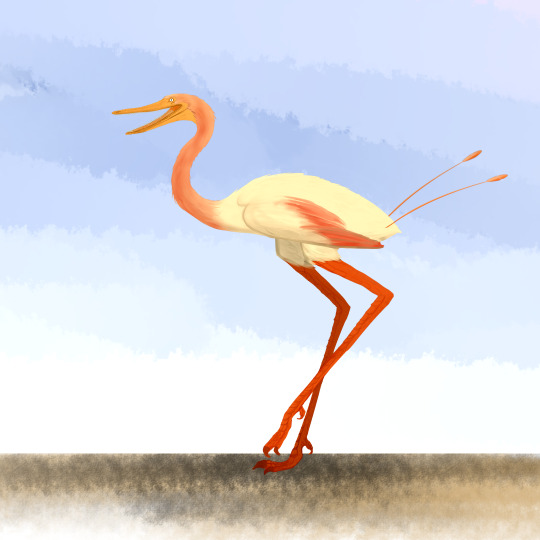
Bennu seti, a filter-feeding bird from Africa, Eurasia and Australia. Like flamingos it metabolizes carotenoids, giving it an orange colouration. By Dave García.
The Cretaceous Lectavis had long legs in some aspects convergent with those of flamingos. Thus, several enantiornitheans developed wading ecologies, ironically more associated with their euornithean competitors. Some became probers, dipping their maws (or toothless beaks) into the subtrate, while others became piscivores like herons or aquatic plant specialists like some cranes and magpie geese.
Most spectacular is a filter-feeding clade, Bennuidae. These birds modified their teeth into thin, delicate strands like some Cretaceous pterosaurs, and feed by swallowing water and expelling it, trapping prey in the teeth and keratinous spikes in the tongue. Having the nostrils still at the end of the snout, these birds usually feed in a different position from flamingos: rather than upside down, the lower jaw is submerged, in a manner similar to avocets.
Like most opposite birds the young are superprecocial, starting as plover-like birds before transitioning into a filter feeding lifestyle months later. Though some taxa form protective creches like flamingos, though unlike them they do not feed the young.
Like many of our shorebirds, these are continuous flappers, displaying remarkable endurance as they fly non-top for days in their migrations.
#enantiornithes#enantiornithean#enatiornithine#bird#birds#dinosaur#dinosaurs#paleoblr#palaeoblr#speculative zoology#speculative evolution#speculative biology#spec evo
26 notes
·
View notes
Text

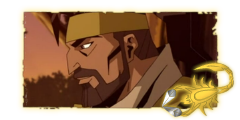

Anyone can be consistent for a few days, but it is harder to be consistent for years upon years, through ups, downs, and everything in between. Here are some ideas that resonates with Hanzo/Scorpion the most when it comes to what it takes to stay steady amidst challenge and grow from change as his character showed throughout the years, most importantly through MKX-MK11.
View life as a continuous cycle of order, disorder, and reorder; while he may crave order and stability, but he knows that stability is a moving target - it's always something new. It doesn't come from resisting change, but it comes from working along with it. He knows he is always somewhere in the cycle of order, disorder, and reorder.
His expectations shape his reality; If he is strenuously training for a mission and expect it to feel easy when he is never pushing beyond his limitations, he will be in for a rude awakening. If he expects it to feel terrible, he will be prepared to grind; perhaps on a good day, he will even be pleasantly surprised. He knows this is true for all hard things.
Lasting progress requires him to be rugged and flexible; To be rugged is to be tough, determined, and durable - it is about showing up over and over again. To be flexible is to adapt and bend easily without breaking - to make adjustments and be fluid when needed. He adopted a mindset that embraced both, and he utilizes the positive aspects of them.
Embrace tragic optimism; acknowledge, accept, and expect that life will contain hardship and hurt, and then do everything he can to trudge forward with a positive attitude nonetheless (further explained in this post). There is a huge space between toxic positivity and despair, and he tries to live in that space.
Diversify his sense of identity; The more he defines himself by any one activity, the more fragile he becomes. If that activity doesn't go well or changes, he loses a sense of who he is. The opposite is "self-complexity," a term researchers use for having multiple components to his reality (for my portrayal of Hanzo/Scorpion, it is him being a warrior, leader, father, husband, poet, artist, philosopher, etc.).
During periods of uncertainty, separate what he can control from what he cannot, and focus on the former. This allows him to respond instead of reacting. He is self-confident and self-assured, because he knows he can navigate through challenges.
Stay patient: It is a nine-inning game. Give things time and space to unfold. Don't try to escape life by moving at warp speed. Don't expect instant results and quit when they don't happen. Go from being a seeker to a practitioner. Stay on the path instead of always veering off.
When life is really challenging, it's okay if his profession simply becomes showing up. It is true that he often grows from adversity (regardless of verses), but that growth happens on the other side. When he is in the thick of it, he focuses on getting through. As simple as that, that is more than plenty and enough (Hanzo/Scorpion struggles with this the most).
#✗ obsessive cathartic (headcanon)#✗ the ineffable testimony of spawned hellfire (scorpion)#✗ seeking reconciliation with his own humanity (iii)#✗ hellfire fibrillating beneath his skin (iv)#(he is obviously not perfect by any means but)#(DAMN HE TRIES HIS BEST)#(although his best could bring atrocious results aka MKX)#(just look at how my boi changed from MKX and MK11)
3 notes
·
View notes
Text
ok lets talk wips!!!
from the ask that i answered a couple days ago:
soulmate aus that i was almost done with [completed!!!! a win for me!!!!]
like a box of chocolates [both svt and skz] - working title, not set in stone. similar to the flower fics i wrote for svt + trsr back in the day where they all have some kind of trope associated with each kind of chocolate.
bodyswap aus for skz + svt. [woozi for svt, lee know for skz]. - admittedly my plans are on pause because i never came up with group names for the fake idol groups i made up for each. basically soulmate au where they end up swapping bodies until they fall in love with the added complicated layer of both being in a small idol group.
i won't run away [lee know] - fem!reader follow-up to i can't run away [vernon fic] where reader moves on.
keep it simple, stupid! [paboracha] - paboracha are all mutually pining with their respective readers and the rest of skz makes a bet on who will realize its mutual the soonest and confess (or get confessed to). minho's in love with his roommate, hyunjin's in love with his best friend, jisung is in love with his study partner for class.
childhood friends -> lovers [seungmin] - a much more recent idea for seungmin in the same vein as when i grow up where it's snapshots of the two growing up together and falling in love. very much 'one falls first, the other falls harder.'
shadow [UtS poly ending] - the poly au that has some more story to it, imo? more emotional topics and some angst. everyone is in love with everyone.
vague summer svt fic? [full group] - not to be released rn if i go for it, but i'm open to tossing ideas around for some summer-themed fics. might include skz (and if anyone's interested/i feel up to writing them, trsr) as well? it'd most likely be a july release just to give myself time to write all the fics and i'd probably give myself some sort of hard limit on how many words they can be.
ok these next few are chubby!fem!reader so if i do write them, i think they'll most likely get posted alongside something else since ik its not a widespread audience!!
untitled chubby!fem!reader fic [felix] - originally a smau i'll have to reconfigure in the same way as lhc, basically lhc but for felix. set after the best friends -> lovers jisung fic that i wanna rewrite! felix deals with the aftermath of a broken heart and ends up befriending reader who he falls for quickly bc she's cute n sunshine-y. very much lonely hearts club but i'll be removing the social media aspect from it.
chubby!fem!reader fake dating au [seokmin] - college au. reader has never dated before and asks seokmin if he'll go on a date or two with her just to help her get over the scary 'first time going on a date' feelings. he turns her down because fucking up is kind of part of the experience, but ends up agreeing to it after he lies and says he's dating reader to get someone who won't take no for an answer off his back. they agree to fake date until after reader's cousin's wedding... and u kno the drill w fake dating!! these bitches start falling for each other!!!
chubby!fem!reader sculptor/muse [woozi] - jihoon is a grad school art student who needs to diversify his portfolio a Lot (man just keeps sculpting his best friend bc he offered to model for him). soonyoung goes 'i know someone' and gets reader in to be jihoon's new model and oops they start catching feelings for each other over time. also has mentions of past mingyu/reader.
i am like 90% sure theres more because i KNOW i had fics planned around on//ew's (censored to keep out of search results, hopefully) album circle (some of which have initial drafts that i wanna rewrite) and an au built veeeeery loosely around the case 143 mv but i wanna workshop both of those more before i mention em any further.
2 notes
·
View notes
Note
if your still doing these, my unpopular opinion is that a lot of the hype around characters that aren't Hawkeye, BJ and Trapper feels very shallow. There is only a few people that actually make thoughtful commentary or general fanwork about Klinger and Margaret. I give the benefit of the doubt to people who scream happily about very minor characters such as Nurse Kellye or Oliver, because they hardly appear, but otherwise? Seems fake.
oh yeah, the door is still open for anyone who want to send one in.
so this is highly subjective but i think i understand the vibe you're talking about. and while i don't think it's worth getting really worked up about, i think it's good to notice these things and point them out... that's generally my MO lol.
i'm trying to think of a way to put it in practical, even measurable terms... well, @thebreakfastgenie pointed out one time that margaret has a lot going on for her, canonically in terms of repression, but that trait gets assigned to BJ a lot (which in and of itself isn't wrong. i'm not saying anyone should feel bad about it) even though it's mostly a headcanon and margaret is right there looking into the camera telling us "i'm repressed"
with klinger i think his being militantly (no pun intended) anti-military, more so than any other character with the exception of hawkeye, who i would argue is his equal, tends to be overlooked. i even think he deserves more credit for this attitude than trapper does. like in the great fandom civil war of 'who was a better partner for hawkeye' klinger is the character who, imo, checks the most boxes: was there the whole time, did not leave without saying goodbye, shares similar core values, does countless acts of love and kindness towards hawkeye, direct action against the army...
most of the time, i don't think this is nefarious. like i don't think anyone is consciously thinking to themselves "i am going to purposely ignore margaret and make a meme or write a fic about repressed beej". i think it's unconscious bias, which is why it's important that anyone who notices it happening point it out and maybe generate the content you think is missing from the space. the more you introduce alternative perspectives, narratives and experiences the more likely it is people are to break from their standard ways of thinking. on the flip side of that, the more our 'notions' are reinforced, by media, by people in our immediate surroundings, by people online, the less likely we are to challenge them.
this is what "representation is important" was originally meant to do. unconscious bias is responsible for so many of our 'notions' that we can't really explain e.g. picture someone making dinner for their three kids, what gender are they?
now picture a character who has a close relationship with their best friend, they're very affectionate, and perhaps this character is a deeply repressed gay person - what gender are they? what race? what might their personality be like? what do you think they're like in bed?
there's no wrong answer. it could be a man or a woman making dinner, and neither BJ nor margaret have a monopoly on repression, but what are you more likely to think? you can play this game by yourself and no one has to know, but to your point, we tell on ourselves all the time, and other people can pick up on these things.
unfortunately movements like "representation is important" was tied up in a lot of like... yelling at people that they must diversify their tastes and to me this is counterproductive. people change very, very slowly and not in any lasting way when they're motivated by fear or shame. not only are some people more likely to become entrenched in their original views, but you also get what you're describing in your ask - this performance of caring about something in a very shallow way, but no tangible actions to support this, and back pats all around none more affirming than the ones we give ourselves. and that to me is even harder sometimes to unlearn. the idea that you're 'done' dismantling unconscious bias, which is a life-long process.
woooooof, sorry i got kind of carried away there. my final answer is: i agree, i just try to be tactful when pointing it out so as to not do more damage.
19 notes
·
View notes
Text
I'm not a fan of this narrative in many autistic writing spaces that writing autistic characters is easy for autistic people, that we do it naturally, that we do it by accident and it requires no thought whatsoever. I think it's a gross oversimplification of what it means to write autistic characters well and promotes stagnation in your portrayal of autistic characters.
It's true that many autistic writers will accidentally make characters autistic/struggle to write non-autistic characters because our own autistic thought patterns are so ingrained to us. For many of us, writing autistic characters feels like second nature. What I resent is the assumption that a) this is true for all autistic writers, and b) this means you're automatically great at writing autistic characters.
First: this is not true for all autistic writers. I actively practiced writing autistic characters for years by creating isolated scenarios specifically about autism to explore what you'd have to do to write autistic characters, before I felt like I had the skill to write autistic characters in scenarios not specifically about autism. I am still practicing. I don't think I'll ever stop practicing. Incorporating autism into the narrative did not come naturally to me. I'm sure that I regularly incorporate autistic traits and patterns into characters intended to be neurotypical on accident, but to me, that is not the same as writing an autistic character and does not translate to writing autistic characters naturally. Stating 'autistic writers don't struggle to write autistic characters' as a universal truth is just wrong.
Second, even if you do feel like it comes naturally to you to write autistic characters, you should note that what you are writing is a reflection of yourself. You do not represent all or even the majority of autistic people. If you want to diversify your portrayal of autism by incorporating autistic traits that you do not have, you will likely have to practice. If you only rely on your personal experiences with autism to inform all of your autistic characters, you will create a one-dimensional portrayal of autism.
Third, something you will quickly notice if you seriously try to write different autistic characters is that the traditional narrative tools utilized in writing are often unsuited for autistic characters. An easy example: eye contact is often used in dialogue to signify importance. If a piece of dialogue is especially important, the author will often have the character 'turn to look at [protagonist]'/'look [protagonist] straight in the eye' to signal to the reader that they need to pay attention. If you have created a character who hates eye contact, do you still do this? Would your character be able to look someone in the eye, even if what they are saying is important? If not, how else do you signal to the reader that this piece of dialogue is important and they need to pay attention? What do you imply when eye contact is utilized as an important, foundational aspect of conversation?
That's an easy example that's pretty easy to solve if you give it a few seconds of thought. There are ones that are a lot harder. How do you write from the perspective of a non-verbal autistic person who does not think in words, in a medium relying entirely on words to convey thought? (That's something I still struggle with greatly and do not feel confident in writing, but hope to figure out through practice.) A lot of basic narrative structures and cheats that authors take for granted fall apart the moment you try to apply them to a character who is sufficiently removed from them. This can very much apply to autistic characters.
For me, the trick in writing autistic characters is less in making them stim or be socially awkward or whatever, and more in thinking about how them being autistic affects basic narrative structures. Autistic people often stim; in what ways can you use stims to your advantage in characterization? How do you show intimacy in characters who are touch-averse? How do you make it clear what your other characters are feeling when you're writing from the limited perspective of a character who cannot tell? Do you even want to, or would it be more effective if you didn't? Again, basic examples, but you get my point.
I believe that relying on a kind of 'natural instinct' when writing autistic characters often leads to rather boring portrayals of autism. I don't mean to discount it entirely; it can obviously be helpful, and there are many people for whom overcoming a reliance on writing clichés is much more natural than it is for me. But by taking your ability to write autistic characters for granted, you may be passing up the opportunity for much more diverse, creative portrayals of autism. It is worth thinking about the ways you write your characters, what kind of personality traits you often give them, and how you can make your character's voice more unique while writing. This advice is by no means limited to autistic characters or even minority characters; it's general writing advice.
And of course: utilizing neurotypical writing tools to write autistic characters will create flattened portrayals. Figuring out how and to what degree you wish to discard writing conventions is, in my opinion, integral for writing good autistic characters.
#my posts#writing wise#actuallyautistic#yeah i'll throw this in the main tag. I am passionate about this#i'm not gonna pretend like i'm some kind of flawless expert who's great at writing autistic characters of all kinds all the time#as i said specifically i still very much struggle with certain kinds of autistic characters#non-verbal characters are especially difficult for me because the way I view the world centers so heavily around language#and that's the point to me!#your own experience with autism is by no means representative of the whole of the autistic experience!#certain autistic characters can fit fairly easily into a neurotypical narrative. others absolutely cannot#i think it's worth practicing and experimenting with all kinds of autistic characters#rather than relying purely on your own experience
2 notes
·
View notes